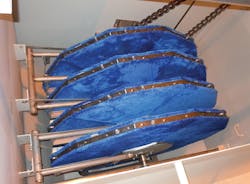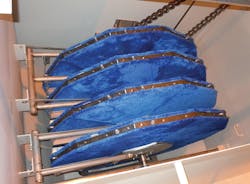With more than 20 years of application experience in wastewater tertiary processes, cloth media filtration (CMF) has demonstrated the ability to offer high solids loading capacity, large hydraulic throughput, small footprint, and high-quality effluent.
To verify whether CMF can effectively treat primary influent and attain significant downstream energy savings -- in addition to energy harvesting through carbon diversion -- a pilot study was conducted at the Rock River Water Reclamation District (RRWRD) in the city of Rockford, Ill., between April and August 2014. The testing was primarily designed to understand the hydraulic and solids loading capabilities of two filtration media, including a standard-fine cloth media filter (SF-CMF) and ultra-fine microfiber cloth media filter (UF-CMF).
The treatment train employed in the pilot study consisted of raw sewage coarse screening (1/4-inch openings) and grit removal followed by parallel operation of both the CMF and existing primary clarifiers. The initial testing was conducted with SF-CMF virtually uninterrupted for 30 days. Subsequently, UF-CMF was tested in lieu of SF-CMF under similar operational conditions. During the testing period, the common influent of CMF and primary clarifier system exhibited total suspended solids (TSS) ranging from 104 to 526 mg/L with an average concentration of 236 mg/L.
While efficiently designed and operated primary sedimentation systems are expected to remove approximately 65 percent TSS, the average removals demonstrated in the study revealed nearly 80 and 90 percent for SF-CMF and UF-CMF, respectively. Additionally, the SF-CMF media demonstrated nearly 54 percent BOD5 removal, while the existing primary clarifiers attained 44 percent removal. By comparison, the UF-CMF media exhibited the best performance with an overall 64 percent BOD5 removal efficiency.
These findings suggest that the use of CMF may reduce the energy needed to oxidize carbonaceous material in the downstream activated sludge system by 30 to 45 percent over conventional primary sedimentation. Significant reductions in organics, as measured by BOD5 values, also indicate the potential for CMF to emerge as a valid technology to potentially improve gas production (energy harvesting) in the anaerobic digestion system.
Lastly, the high solids loading capacity of about 10 lbs TSS/ft2-day attained for both cloth media in this study suggests that CMF is able to take less than 10 percent of the footprint of a conventional primary settling basin while still providing better quality effluent.
Overall, the test supports the application of AquaDisk technology in conjunction with OptiFiber cloth filtration media to effectively filter screened, de-gritted raw municipal sewage. Both cloth media demonstrated a capacity to handle significantly higher solids loading rates than typically used on secondary clarified effluent (by a factor of 3 to 5 times). The range of influent TSS observed (104-526 mg/L) and average sustained concentration (236 mg/L) suggests that cloth media filtration is applicable for both combined sewer overflow (CSO) treatment, as well as primary treatment in lieu of conventional sedimentation systems.
The system is able to produce consistent, high-quality effluent performance throughout the variable influent conditions. Significant reductions in organics, as measured by BOD5 and COD values, indicate the potential for cloth media filtration to emerge as a valid technology to reduce energy demands in downstream aeration basins and potentially improve gas production (energy recovery) in anaerobic digestion systems.
Aqua-Aerobic is an exhibitor at WEFTEC.15 and can be found at Booth 612. For more information, visit www.aqua-aerobic.com.




